[0] 참고자료
- PyTorch로 시작하는 딥 러닝 입문 유원준 외 1명
- 딥러닝 파이토치 교과서 서지영
[5] 소프트맥스 회귀 Softmax Regression
1. One-Hot Encoding
what?
- 선택해야 하는 개수만큼의 차원을 가지면서, 각 선택지의 인덱스에 해당하는 원소에는 1, 나머지 원소는 0의 값을 가지도락 하는 방법
1
2
3
강아지 = [1, 0, 0]
고양이 = [0, 1, 0]
앵무새 = [0, 0, 1]
why?
예를 들어 강아지 = 1, 고양이 = 2, 앵무새 = 3 라고 레이블을 주었을 때, 손실 함수로 MSE를 사용한다면, 실제 값이 강아지 일 때 예측값이 고양이였다면 (2 - 1)^2 = 1, 실제 값이 강아지 일 때 예측값이 앵무새였다면 (3 - 1)^2 = 4, 즉, 강아지와 고양이가 가깝다는 정보를 주는 결과가 됨
-> 대부분의 분류 문제가 클래스 간의 관계가 균등하므로, 원-핫 인코딩을 많이 사용하게 됨
2. 소프트맥스 회귀
- 로지스틱 회귀

- 소프트맥스 회귀

-> 소프트맥스 회귀는 선택지의 개수만큼의 차원을 갖는 벡터를 만들고, 벡터의 모든 합이 1이 되는 어떤 함수를 만들어야 함
- 가중치 계산
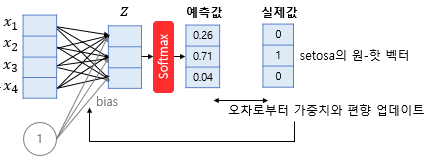
-> One-Hot 인코딩 된 실제값과 비교하여 Weight와 Bias를 업데이트 한다
3. 비용함수 구현하기
1) low-level
1
2
3
4
5
6
7
8
9
10
11
12
13
14
15
16
17
18
19
20
21
22
23
24
25
26
27
28
29
30
31
32
import torch
import torch.nn.functional as F
torch.manual_seed(1)
# 3 x 5 크기의 텐서 생성
# 5개의 클래스를 갖는 3개의 샘플
z = torch.rand(3, 5, requires_grad=True)
# 소프트맥스 적용
hypothesis = F.softmax(z, dim=1)
# 임의의 레이블 생성
y = torch.randint(5, (3,)).long()
# 모든 원소가 0의 값을 가진 3 x 5 텐서 생성
y_one_hot = torch.zeros_like(hypothesis)
# y.unsqueeze(1)를 하면 (3,)의 크기였던 y가 (3x1)텐서가 됨 : tensor([[0], [2], [1]])
# scatter 첫번째 인자: dim=1 에 대해 수행
# scatter 세번째 인자: 두번째 인자가 알려주는 위치에 숫자 1
# 연산 뒤에 _가 붙은 경우 덮어쓰기 함
y_one_hot.scatter_(1, y.unsqueeze(1), 1)
# 결과
# tensor([[1., 0., 0., 0., 0.],
# [0., 0., 1., 0., 0.],
# [0., 1., 0., 0., 0.]])
# 비용 함수
cost = (y_one_hot * - torch.log(hypothesis)).sum(dim=1).mean()
2) high-level
1
2
3
4
5
6
7
8
9
10
11
12
13
14
15
# 1. low level 수식
#hypothesis = F.softmax(z, dim=1)
#cost = (y_one_hot * - torch.log(hypothesis)).sum(dim=1).mean()
# 2. 축약
cost = (y_one_hot * - torch.log(F.softmax(z, dim=1))).sum(dim=1).mean()
# 3. F.log_softmax
#torch.log(F.softmax(z, dim=1)) 가 많이 사용되므로, F.log_softmax 로 제공됨
cost = (y_one_hot * - F.log_softmax(z, dim=1)).sum(dim=1).mean()
# 4. 잔여 기능이 포함된 함수
cost = F.nll_loss(F.log_softmax(z, dim=1), y)
# 5. 모든 기능이 포함된 함수
cost = F.cross_entropy(z, y)
4. MNIST 데이터 분류
1. MNIST
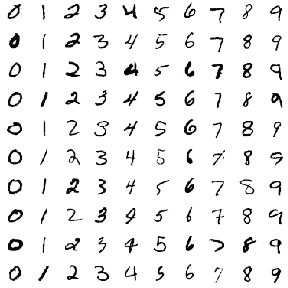
- 숫자 0부터 9까지의 이미지로 구성된 손글씨 데이터셋
- 60,000개의 훈련데이터와 레이블, 10,000개의 테스트 데이터와 레이블로 구성됨
- 레이블은 0부터 9까지 총 10개
- 각 이미지는 28 x 28 픽셀
1
2
3
4
5
6
7
8
9
10
11
12
13
14
15
16
17
18
19
20
21
22
23
24
25
26
27
28
29
30
31
32
33
34
35
36
37
38
39
40
41
42
43
44
45
46
47
48
49
50
51
52
53
54
55
56
57
58
59
60
61
62
63
64
65
66
67
68
69
70
71
72
73
74
75
76
77
78
79
80
81
82
83
84
85
86
87
88
89
90
91
92
93
94
95
96
97
98
99
100
101
102
103
104
105
106
# torchvision은 유명한 데이터셋들, 이미 구현된 유명 모델들, 일반적인 전처리 도구들을 포함하고 있음
# 자연어처리는 torchtext 사용
import torch
import torchvision.datasets as dsets
import torchvision.transforms as transforms
from torch.utils.data import DataLoader
import torch.nn as nn
import matplotlib.pyplot as plt
import random
# GPU 연산이 가능하다면 GPU 사용
USE_CUDA = torch.cuda.is_available()
device = torch.device("cuda" if USE_CUDA else "cpu")
print("다음 기기로 학습합니다:", device)
# 랜덤시드 고정
random.seed(777)
torch.manual_seed(777)
if device == 'cuda':
torch.cuda.manual_seed_all(777)
# hyperparameters
training_epochs = 15
batch_size = 100
# MNIST dataset
# root : MNIST를 다운로드 받을 경로
# train : 학습에 사용할지 여부
# transform : 파이토치 텐서로 변환
# download : 데이터가 없을 때 다운로드 받을지 여부
mnist_train = dsets.MNIST(root='MNIST_data/',
train=True,
transform=transforms.ToTensor(),
download=True)
mnist_test = dsets.MNIST(root='MNIST_data/',
train=False,
transform=transforms.ToTensor(),
download=True)
# 데이터 로드
# drop_last : 배치 크기로 데이터를 나누었을 때, 나머지가 발생하면 버릴 지 여부
# 나머지의 갯수가 너무 적은 경우 상대적으로 과대평가 될 수 있음
data_loader = DataLoader(dataset=mnist_train,
batch_size=batch_size, # 배치 크기는 100
shuffle=True,
drop_last=True)
# 모델 설계
# input_dim = 28 x 28 = 784
# output_dim = 10 : 10개의 클래스이므로
# .to() 어떤 장치를 사용해서 연산할 지 지정
linear = nn.Linear(784, 10, bias=True).to(device)
# 비용 함수와 옵티마이저 정의
criterion = nn.CrossEntropyLoss().to(device)
optimizer = torch.optim.SGD(linear.parameters(), lr=0.1)
# torch.nn.functional.cross_entropy()
# torch.nn.CrossEntropyLoss()
# nn 에 포함된 기능은 클래스형, nn.functional에 포함된 기능은 함수형. 기능은 같음
# 학습
for epoch in range(training_epochs): # 앞서 training_epochs의 값은 15로 지정함.
avg_cost = 0
total_batch = len(data_loader)
for X, Y in data_loader:
# 배치 크기가 100이므로 아래의 연산에서 X는 (100, 784)의 텐서가 된다.
X = X.view(-1, 28 * 28).to(device)
# 레이블은 원-핫 인코딩이 된 상태가 아니라 0 ~ 9의 정수.
Y = Y.to(device)
optimizer.zero_grad()
hypothesis = linear(X)
cost = criterion(hypothesis, Y)
cost.backward()
optimizer.step()
avg_cost += cost / total_batch
print('Epoch:', '%04d' % (epoch + 1), 'cost =', '{:.9f}'.format(avg_cost))
print('Learning finished')
# 모델 테스트
with torch.no_grad(): # torch.no_grad()를 하면 gradient 계산을 수행하지 않는다.
X_test = mnist_test.test_data.view(-1, 28 * 28).float().to(device)
Y_test = mnist_test.test_labels.to(device)
prediction = linear(X_test)
correct_prediction = torch.argmax(prediction, 1) == Y_test
accuracy = correct_prediction.float().mean()
print('Accuracy:', accuracy.item())
# MNIST 테스트 데이터에서 무작위로 하나를 뽑아서 예측을 해본다
r = random.randint(0, len(mnist_test) - 1)
X_single_data = mnist_test.test_data[r:r + 1].view(-1, 28 * 28).float().to(device)
Y_single_data = mnist_test.test_labels[r:r + 1].to(device)
print('Label: ', Y_single_data.item())
single_prediction = linear(X_single_data)
print('Prediction: ', torch.argmax(single_prediction, 1).item())
plt.imshow(mnist_test.test_data[r:r + 1].view(28, 28), cmap='Greys', interpolation='nearest')
plt.show()
[6] 인공 신경망
1. 퍼셉트론
- 퍼셉트론 Perceptron
- 초기 형태의 인공 신경망
- 다수의 입력으로부터 하나의 결과를 내보내는 알고리즘
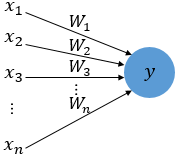
1
2
3
- x :입력 값
- W : Weight 가중치
- y : 출력값
- 각 입력값이 가중치와 곱해져 뉴런에 보내지고, 뉴런에서는 입력값x가중치의 합이 입계치를 넘으면 1을 출력
- 즉, 다음과 같은 계단 함수
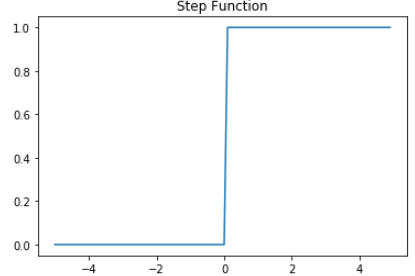
- 임계치를 포함한 퍼셉트론
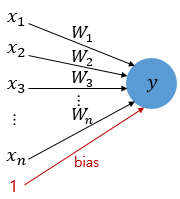
2. 단층 퍼셉트론
입력층(input layer), 출력층(output layer) 두 단계로만 구성됨
논리게이트 문제
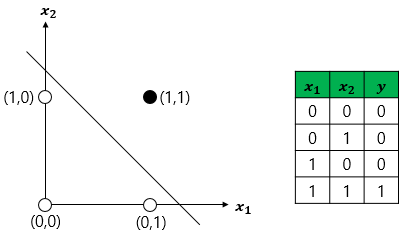
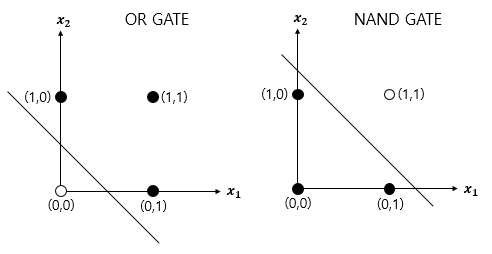
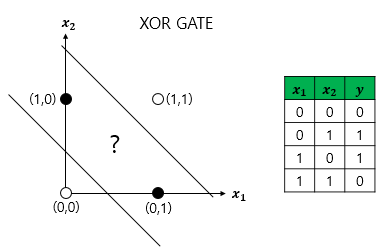
1
2
3
4
5
6
7
8
9
10
11
12
13
14
15
16
17
18
19
20
21
22
23
24
25
26
27
28
29
def AND_gate(x1, x2):
w1=0.5
w2=0.5
b=-0.7
result = x1*w1 + x2*w2 + b
if result <= 0:
return 0
else:
return 1
def NAND_gate(x1, x2):
w1=-0.5
w2=-0.5
b=0.7
result = x1*w1 + x2*w2 + b
if result <= 0:
return 0
else:
return 1
def OR_gate(x1, x2):
w1=0.6
w2=0.6
b=-0.5
result = x1*w1 + x2*w2 + b
if result <= 0:
return 0
else:
return 1
3. 다층 퍼셉트론 MLP MultiLayer Perceptron
- XOR 게이트는 AND, NAND, OR 게이트를 조합하면 만들 수 있음.
- 즉, layer를 더 쌓으면 만들 수 있음
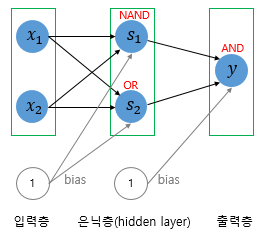
- 이와 같이 입력층과 출력층 사이에 존재하는 것을 은닉층 hidden layer 라 함
1
2
3
4
5
6
7
8
9
10
11
12
13
14
15
16
17
18
19
20
21
22
23
24
25
26
27
28
29
30
31
32
33
34
35
36
37
38
39
40
41
42
43
44
45
46
47
48
49
50
51
52
53
import torch
import torch.nn as nn
device = 'cuda' if torch.cuda.is_available() else 'cpu'
# for reproducibility
torch.manual_seed(777)
if device == 'cuda':
torch.cuda.manual_seed_all(777)
X = torch.FloatTensor([[0, 0], [0, 1], [1, 0], [1, 1]]).to(device)
Y = torch.FloatTensor([[0], [1], [1], [0]]).to(device)
model = nn.Sequential(
nn.Linear(2, 10, bias=True), # input_layer = 2, hidden_layer1 = 10
nn.Sigmoid(),
nn.Linear(10, 10, bias=True), # hidden_layer1 = 10, hidden_layer2 = 10
nn.Sigmoid(),
nn.Linear(10, 10, bias=True), # hidden_layer2 = 10, hidden_layer3 = 10
nn.Sigmoid(),
nn.Linear(10, 1, bias=True), # hidden_layer3 = 10, output_layer = 1
nn.Sigmoid()
).to(device)
# 비용함수와 옵티마이저 선언
# nn.BCELoss() 는 이진 분류에서 사용하는 크로스엔트로피 함수
criterion = torch.nn.BCELoss().to(device)
optimizer = torch.optim.SGD(model.parameters(), lr=1) # modified learning rate from 0.1 to 1
# 학습
for epoch in range(10001):
optimizer.zero_grad()
# forward 연산
hypothesis = model(X)
# 비용 함수
cost = criterion(hypothesis, Y)
cost.backward()
optimizer.step()
# 100의 배수에 해당되는 에포크마다 비용을 출력
if epoch % 100 == 0:
print(epoch, cost.item())
# 학습 결과 확인
with torch.no_grad():
hypothesis = model(X)
predicted = (hypothesis > 0.5).float()
accuracy = (predicted == Y).float().mean()
print('모델의 출력값(Hypothesis): ', hypothesis.detach().cpu().numpy())
print('모델의 예측값(Predicted): ', predicted.detach().cpu().numpy())
print('실제값(Y): ', Y.cpu().numpy())
print('정확도(Accuracy): ', accuracy.item())
